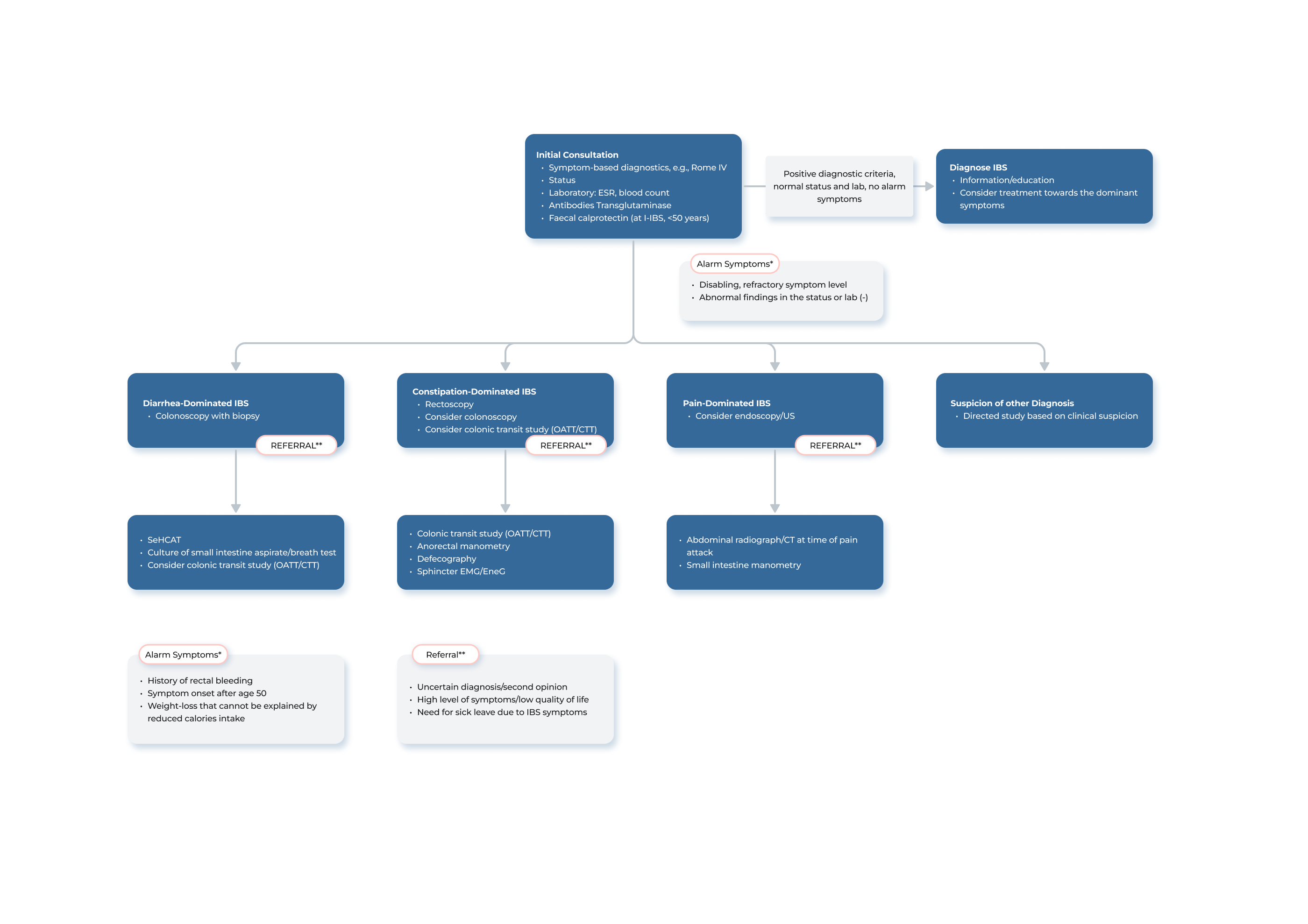Validated and Widely Accepted: A Clinical Solution
The Transit-Pellets method, formerly known as the Abrahamsson method, is clinically useful in patients experiencing symptoms of a transit disturbance, which may have pathophysiological and clinical significance, such as chronic constipation or chronic diarrhoea. The Transit-Pellets principle involves the ingestion of ten Transit-Pellets radiopaque markers per day for six consecutive days, followed by a single abdominal X-ray or fluoroscopy on the seventh day to count the number of remaining markers. Colonic transit time is calculated as the mean oro-anal transit time (OATT, mouth-to-anus) for the daily marker doses swallowed. Because the colonic transit constitutes the main part of the mouth-to-anus transit time, OATT is used as a measure of colonic transit.
The Transit-Pellets method is the leading technology used for colonic transit studies in regions such as Scandinavia, Europe, Australia, and New Zealand, and it has recently been introduced in the United States. With its proven track record of accuracy and reliability, the Transit-Pellets method and the Transit-Pellets device is the preferred choice of many medical professionals for colonic transit studies.
”A colonic transit test with radiopaque markers is a very useful test to provide objective confirmation of a patient´s subjective complaint of altered frequency of defecation”
(Keighley et al., 2018).
The Transit-Pellets method can measure rapid, normal and slow colonic transit
Given that the X-ray on day 7 after ingestion of 10 markers daily for six days is performed in the saturation state, i.e. that the number of retained markers is in the interval 3-55 markers, the CTT can be given in numerical values, e.g., in days with one decimal. The corresponding CTT will be 0.3 – 5.5 days. Since the reference values (percentiles 5 – 95) for healthy women is 0.6 – 4.0 days and in men 0.5 – 2.2 days, the whole spectrum from rapid to slow transit values can be numerically calculated. 1
If saturation has not been achieved, i.e., as a mean less than half of the first marker dose has been excreted (> 55 markers retained) CTT is set to > 5.5 days for that subject. Otherwise, CTT might be underestimated.
If the saturation state has passed, i.e. less than half of the last marker dose (0-2 markers) is retained the CTT is set to < 0.3 days. The capability of the Transit-Pellets method to yield numerical values for rapid, normal as well as slow CTT is unique among CTT radiopaque marker methods used in clinical practice. The daily dose of markers used, 10 daily, gives accuracy in CTT close to that with 20 markers daily, and sufficient for use in clinical practice and in scientific studies. 2
The Transit-Pellets method can differentiate between slow transit and normal transit constipation
Measurements with the Transit-Pellets method show that patients suffering from constipation have CTT either in the normal CTT range or delayed transit time above the reference range.3, 4, 5 In studies of patients with constipation the proportion of slow transit was 50% in functional constipation,3 15% in IBS related constipation,4 and 46% in mixed functional and IBS related constipation.5 With the differentiation shown with the Transit-Pellets method between slow and normal transit constipation it could be demonstrated that the metabolism of bile acids, important for colonic function, is disturbed in patients with slow transit constipation.5
The Transit-Pellets method can identify segmental colon dysfunction in patients with constipation
Transit times in the different segments of colon (ascendent, transverse, descendent and rectosigmoid part) can be measured with the Transit-Pellets method by applying to the segments similar criteria for saturation as used for total CTT. Thus, a numerical value for the transit can be given for segments provided that at least half of a daily dose (5 markers) has passed that segment.
In patients with constipation the Transit-Pellets method can diagnose segmental dysfunction as a delay (increased transit time) in the segment in question. Thus, outlet obstruction is seen as a delay in rectosigmoid transit time.3 The serious constipation disorder colonic inertia is identified with a delayed total CTT and prolonged transit time (>1.5 days) in the ascendant part of colon.3 This identification is clinically important since surgical treatment with colectomy for constipation usually is contraindicated and should only be considered in very selected case if transit is clearly delayed in the right colon.
The Transit-Pellets method can differentiate between normal and rapid transit diarrhoea
The short interval between marker intake and X-ray with the Transit-Pellets method enables investigation of rapid colonic transit in patients with long-lasting diarrhoea. Chronic diarrhoea caused by bile acids (so called IBAM, idiopathic bile acid malabsorption or IBAD, bile acid diarrhoea) is much more common than previously believed. In patients with bile acid diarrhoea CTT is usually markedly decreased. 50% of males and 75% of females with IBAM have rapid CTT. IBAM is a very unlikely diagnose if CTT is >1.1 day in men and >1.5 day in women. In a similar way segmental rectosigmoid transit time is markedly decreased in both men and women with this disorder. A normal rectosigmoid transit time speaks strongly against an IBAM/IBAD diagnose.6
For the functional disorder IBS with diarrhoea (IBS-D) the Transit-Pellets method differentiates between normal and rapid transit diarrhoea. Thus, in 126 patients with IBS-D, 27% had rapid CTT.4 The finding of rapid transit in patients with diarrhoea assists in selecting treatment aimed to slow down colonic transit.
The Transit-Pellets method can identify treatment effects in patients with chronic constipation
The single X-ray Transit-Pellets method with low radiation dose is suitable when repeated CTT measurements are wanted. Therefore, the method has been used to follow treatment effects on both total and segmental colonic transit in constipation.
The IBAT inhibitor elobixibat (A3309) was studied in 30 patients with chronic idiopathic constipation, treatment dose 0.1-10 mg/day. The Transit-Pellets method demonstrated an accelerating effect on CTT, particularly with the highest dose. CTT was reduced by 57% and it was shown that the effect was on the segments from the transverse to the rectosigmoid part where the transit time reduction was 1.7 days.7 Thus, at treatment of constipation the Transit-Pellets method can show both an overall effect on CTT and an effect on the target region in the colon.
- Sadik, R., Abrahamsson, H., Stotzer, P.O. (2003). Gender differences in gut transit shown with a newly developed radiological procedure. Scand. J. Gastroenterol., Vol. 38, 36-42.
- Abrahamsson, H. & Antov, S. (2010). Accuracy in assessment of colonic transit time with particles: how many markers should be used? Neurogastroenterol Motil., Vol. 22, 1164-69.
- Abrahamsson, H., Antov, S., Bosaeus, I. (1988). Gastrointestinal and colonic transit time evaluated by a single abdominal X-ray in healthy subjects and constipated patients. Scand. J. Gastroenterol., Vol. 23 (suppl. 152), 72-80.
- Törnblom, H., van Oudenhove, L., Sadik, R., Abrahamsson, H., Tack, J., Simrén, M. (2012). Colonic transit time and IBS symptoms: what’s the link? Am. J. Gastroenterol., Vol. 107(5), 754-60.
- Abrahamsson, H., Ostlund-Lindqvist, A.M., Nilsson, R., Simrén, M., Gillberg, P.G. (2008). Altered bile acid metabolism patients with constipation-predominant irritable bowel syndrome and functional constipation. Scand J Gastroenterol., Vol. 43(12), 1483-8.
- Sadik, R., Abrahamsson, H., Ung, K.A., et al. (2004). Accelerating regional bowel transit and overweight shown in idiopathic bile acid malabsorption. Am. J. Gastroenterol., Vol. 99, 711-718.
- Simrén, M., Bajor, A., Gillberg, PG., Rudling, M., Abrahamsson, H. (2011). Randomised clinical trial: The ileal bile acid transporter inhibitor A3309 vs. placebo in patients with chronic idiopathic constipation-a double-blind study. Aliment Pharmacol Ther., Vol. 34(1), 41-50.


